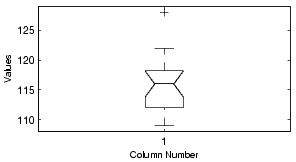| Statistics Toolbox |
  |
Box Plots
The graph shows an example of a notched box plot.

This plot has several graphic elements:
- The lower and upper lines of the "box" are the 25th and 75th percentiles of the sample. The distance between the top and bottom of the box is the interquartile range.
- The line in the middle of the box is the sample median. If the median is not centered in the box, that is an indication of skewness.
- The "whiskers" are lines extending above and below the box. They show the extent of the rest of the sample (unless there are outliers). Assuming no outliers, the maximum of the sample is the top of the upper whisker. The minimum of the sample is the bottom of the lower whisker. By default, an outlier is a value that is more than 1.5 times the interquartile range away from the top or bottom of the box.
- The plus sign at the top of the plot is an indication of an outlier in the data. This point may be the result of a data entry error, a poor measurement or a change in the system that generated the data.
- The notches in the box are a graphic confidence interval about the median of a sample. Box plots do not have notches by default.
A side-by-side comparison of two notched box plots is the graphical equivalent of a t-test. See Hypothesis Tests.
 | Statistical Plots | | Distribution Plots |  |





